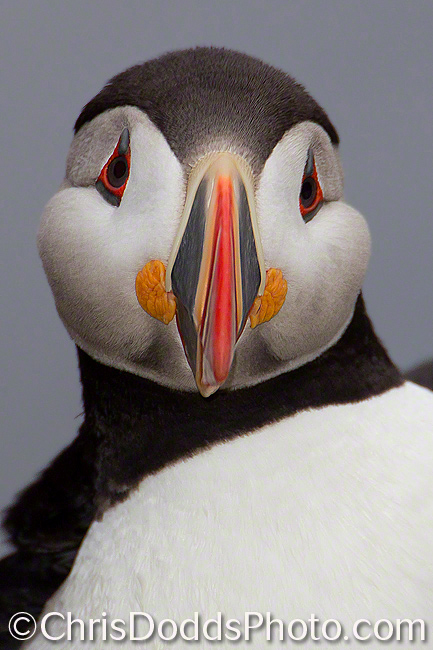
Puffin Photography Workshop/Safari announced July 5-7, 2011
I'm just back from another trip; this time, I went out in search of the ultimate destination for Atlantic Puffins. The mandate was simple; find a location that is within reach, safe and easy to get to without a dangerous boat landing on slippery rocks and a place where we can get close to these comical little seabirds without hauling our gear up, and over, huge distances or having to hang over towering cliffs. I have photographed Atlantic Puffins in Iceland, Maine, Newfoundland, New Brunswick and Quebec; All of these "known" places have their drawbacks. Mission accomplished; I have found Puffin Paradise. Special thanks to the Loiselle Familly of Longue-Pointe-de-Mingan for their gracious hospitality during my time there.
If you are interested in joining me for a Puffin photography workshop July 5-7, 2011, then be sure to send an email to chris@chrisdoddsphoto.com. This trip will be limited to six participants (two spots booked already) and will surely be the trip of a lifetime for anyone seeking to get close and personal (safely) to Atlantic Puffins and Razorbills. We will spend a few hours photographing fishing Puffins each morning from a boat, before landing on an island where we spend the rest of the day until sunset for three full days. I have secured special access, so we will be the only people on the island during the first, and last, few hours each day. Price is CAD$2,495.00 including four nights single occupancy accommodation, three days private boat tour with highly experienced captain, three days park access fees and three days expert instruction. Other subjects might include Razorbill, Black Guillemot, Great Cormorants, Savannah Sparrow (there are many) Common Eider and Grey Seal. More details after my return from teaching the August Gannets Galore workshop in about 10 days. Meals, beverages, transportation to Longue-Pointe-de-Mingan, Quebec and souvenirs are not included.
Testimonial
Many thanks to Chris for a wonderful and exciting photography experience. Your professionalism, talent, patience and knowledge helped to make the Gannets Galore photo trip an experience of a life time. The hundreds of thousands of Northern Gannets on Bonaventure Island were unbelievable. I took thousands of photographs of Northern Gannets in their everyday activities. They were elegant, comical, clumsy, arguing, fishing, sleeping, working, copulating, preening and fencing. It was nonstop and exhilarating. Now, I get to my favourite part - the Zodiac tour around Bonaventure Island. It’s 5:00am and we start the 4 hour trip to see dozens of species of birds and seals as well as couple of Minke whales. The 4 hours seemed to pass like minutes. The Harlequin ducks and Black Guillemots were among my favourites and a real treat to observe and photograph. - Gordie Kadonoff Hampstead | Quebec | Canada
Atlantic Puffin (Fratercula arctica, Macareux moine, ATPU)
The Atlantic Puffin (Fratercula arctica, Macareux moine, ATPU) is a seabird species in the auk family. Also know as “common puffin”, “clown of the ocean”, “clown of the sea” and “sea parrot”, these squat little pelagic birds look comically awkward on land and rather heavy in the air, but once in their element, the water, they become able predators. “Flying” through the sea on stubby wings, they dive-bomb shoals of herring, sand eels, sardines, and other small fish and sometimes squid. These pursuit divers collect their victims one at a time, but can hold as many as 20 small fish crosswise in their brightly coloured beaks at the same time. The Atlantic Puffin is 26–29 centimetres (10–11 in) in length (bill 3-4 cm), with a 47–63 centimetres (19–25 in) wingspan. The male is generally slightly larger than the female, but they are coloured alike. A puffin can fly 48 to 55 mph (77 to 88 km/hr). The puffin beats its wings rapidly to achieve this speed reaching up to 400 beats a minute.
This species breeds on the coasts of northern Europe, the Faroe Islands, Iceland and eastern North America (Canada and New England), from well within the Arctic Circle to northern France and Maine. It is the only Puffin species found in the Atlantic Ocean. The winter months are spent at sea far from land - in Europe as far south as the Mediterranean, and in North America to North Carolina. Puffins often nest in well populated colonies usually on remote, rugged islands free from egg and chick eating land predators. They deposit a single egg deep within a burrow excavated in soft earth, or in a feather, or grass, lined lair in a rocky cleft. After fattening-up their hatchlings on fish, the parents return to the sea. The young Puffins, still unable to fly, eventually scramble to the shore by night and plunge into the water.


